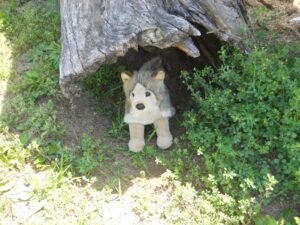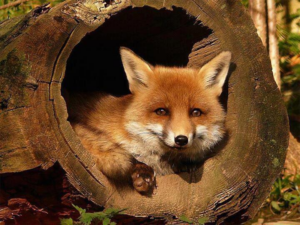Where’s Wolfie #5
Where’s Wolfie #5
 So, did you accurately guess my location last week? Many of you did. I was sitting on the fence at the Early Sawmill Exhibit. I was very impressed with the old-growth log positioned on the sawmill. I wonder how the loggers got logs that big, or bigger, into position without the use of modern equipment. Lots of work, I am sure. Maybe Paul Bunyan, the famous logger of the Northwoods, and his helper Babe the Blue Ox got involved.
So, did you accurately guess my location last week? Many of you did. I was sitting on the fence at the Early Sawmill Exhibit. I was very impressed with the old-growth log positioned on the sawmill. I wonder how the loggers got logs that big, or bigger, into position without the use of modern equipment. Lots of work, I am sure. Maybe Paul Bunyan, the famous logger of the Northwoods, and his helper Babe the Blue Ox got involved.
Speaking of Paul Bunyan, you can find him at the MacKenzie Center. He is located near the entrance to the Conservation Museum. Unfortunately, the museum is closed now due to the Coronavirus, but it will open again when we have the pandemic (widespread disease) under control. In the meantime, Paul asked me to tell you that the trails are still open for people to hike and enjoy. The Wildlife Exhibit is also open. Stop by, see the animals, and say hello to my cousins, the wolves. Sometimes you may hear them, or even see them, howling. I’m just learning to howl - at my age, it sounds more like a squeal or a squeak.
 Well, this week I am again by a big log. In fact, this one is hollow throughout its entire length. Johnny’s dad said that it is rotten to the core, just like some people. That’s another one of his jokes that I don’t understand. Why would some people want to be rotten to the core? And what’s a politician?
Well, this week I am again by a big log. In fact, this one is hollow throughout its entire length. Johnny’s dad said that it is rotten to the core, just like some people. That’s another one of his jokes that I don’t understand. Why would some people want to be rotten to the core? And what’s a politician?
Last week, Johnny took me to his school, and I got to sit in on one of his science classes. His science teacher told us that many animals make use of holes in trees. Some holes are created from the weather snapping off limbs and branches. Others are caused by diseases that affect the wood. Some birds, known as woodpeckers, can actually create their own hole by pecking the tree with their beaks. I bet that causes a headache or two. In spring, you can hear the birds ‘drumming’ away on the tree trunks and branches. The woodpeckers lay their eggs and raise their young in these nest holes.
Once the woodpeckers have moved out of their nest hole, other birds might move in. Chickadees, nuthatches, some wrens, and even  owls might make use of the hole. Some ducks, like the wood duck, also nest in holes in trees. If you and your family have hiked the MacKenzie trails, you may have seen wooden bird boxes scattered around the property. These boxes were constructed by people, placed on poles, and are used by tree swallows, bluebirds, and kestrels (a small, colorful falcon). Sometimes, the D.N.R. staff and Friends of MacKenzie volunteers have classes where students help build these houses. Then, they take them home and place them on their property. Some of the bird species actually raise more than one set of youngsters each year. I’m sure that keeps mom and dad busy.
owls might make use of the hole. Some ducks, like the wood duck, also nest in holes in trees. If you and your family have hiked the MacKenzie trails, you may have seen wooden bird boxes scattered around the property. These boxes were constructed by people, placed on poles, and are used by tree swallows, bluebirds, and kestrels (a small, colorful falcon). Sometimes, the D.N.R. staff and Friends of MacKenzie volunteers have classes where students help build these houses. Then, they take them home and place them on their property. Some of the bird species actually raise more than one set of youngsters each year. I’m sure that keeps mom and dad busy.
Some mammals (hairy critters like me) also use holes in trees and hollow logs. Squirrels nest and seek shelter in tree holes, as do opossums, raccoons, and chipmunks. If a tree has fallen and is lying on the forest floor, the downed log may act as a runway for mice and shrews. The log offers a safe place to quickly hide if a predator is close by. If the log is hollow, foxes, woodchucks, and raccoons may use it as a den or home. Sometimes, they leave behind clues that indicate their presence - tracks, droppings, bits of hair, or scratch marks. A good time to look for tracks is after a snowfall. Each animal species has a unique track that is similar to its signature.
The hollow log that I am sitting near isn’t used too often by animals, it is sitting in the open and doesn’t offer a lot of protection.  However, if you attend a big MacKenzie Center event, like Maple Fest or the Fall Festival, you will see kids sitting on top of, or crawling through, this log. If we have Maple Fest this spring, I think I will help those nice volunteers park cars. In that way, I can welcome visitors to the event, and maybe I could even have my picture taken with some of you. That would be a great way for me to meet you and for you to meet me. Whaddya think?
However, if you attend a big MacKenzie Center event, like Maple Fest or the Fall Festival, you will see kids sitting on top of, or crawling through, this log. If we have Maple Fest this spring, I think I will help those nice volunteers park cars. In that way, I can welcome visitors to the event, and maybe I could even have my picture taken with some of you. That would be a great way for me to meet you and for you to meet me. Whaddya think?
If you would like to learn more about the Sawmill Exhibit, the Conservation Museum, or other exhibits at the MacKenzie Center, take a look at the Wisconsin Department of Natural Resources description at https://dnr.wisconsin.gov/education/mackenzie/museums.
So do you know where I am this week? If so, email your response to this week’s ‘Where’s Wolfie’ contest to [email protected] before 5:00 pm on Friday, September 25th. If you are the prize winner, the Friends of MacKenzie will contact you by email. If there is more than one correct response, the Friends will draw a winning name from the list of correct entries.
Good luck and here’s howlin’ at ya’.
If you want to hear, and see a wolf howl, watch this YouTube video:
https://www.youtube.com/watch?v=fUpQFMEb9po&ab_channel=DebyDixon
Photo Credits:
Number 1 (Wolfie at Sawmill) - John Frank, Friends of MacKenzie
Number 2 (Paul Bunyan) - John Frank, Friends of MacKenzie
Number 3 (Wolfie near Log) - John Frank, Friends of MacKenzie
Number 4 (Pileated Woodpeckers) - www.iawildlife.org
Number 5 (Young Owls) - https://unsplash.com/images/animals/birds
Number 6 (Fox on Log) - Margaret Lueg www.mlueg.freeuk.com



